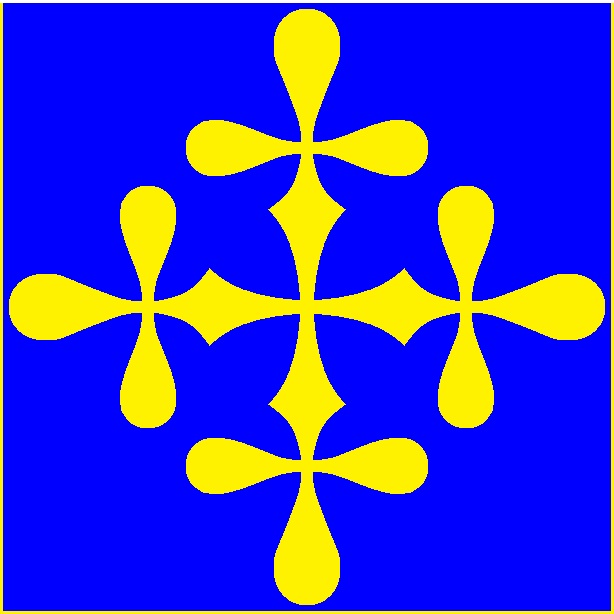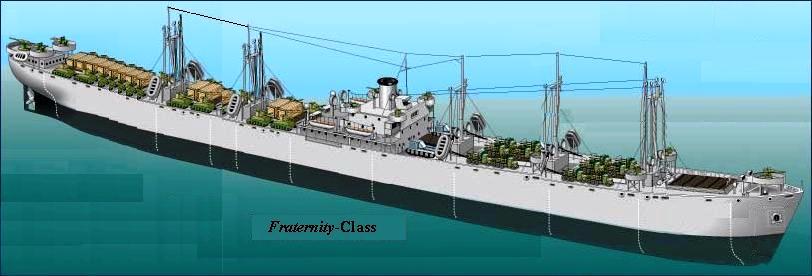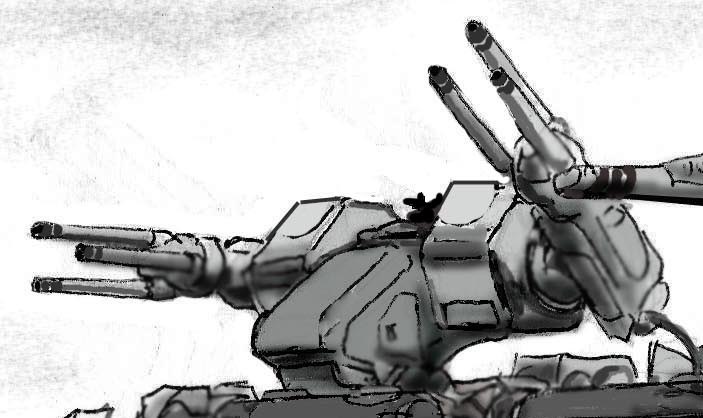
United Galaxies Council. | REF Fraternity-Class Cargo Ship. | 
United Galaxies Council. |
|---|
The Fraternity-Class Cargo Ship is nothing more than 2 Liberty II-Class Cargo ships spliced together (see Liberty-Class Cargo Ship); The bow of one is cut off, as is the stern of another. The 2 hulls are then spliced together to make one super-sized cargo ship. All 6  | | An REF Reconstruction-Era Fraternity-Class Super Cargo Ship. |
|---|
Hydro-Cell engines and most other machinery remains. The only significant machinery that are removed are the rudder, main props, and stern thruster of one ship and bow thruster of the other. The thrusters themselves actually remain, moved to a new position in the hull. The bow doors, however, were removed as the vessel is utterly unable to off-load in this fashion, and are restricted to deep-water ports only.For over 100 years these ships suffered a critical vulnerability; Their great length made them prone to crack apart at the point where the two hulls are joined. For this reason, they were restricted to sailing in seas of less than 10 feet. Satellite observation and on board CS/A-013(a) Satellites (communications and weather variants) assist in avoiding such hazards, and detour as much as 250+ miles to remain safe, or delay setting sail as much as a week in the event of a fast-moving hurricane or other major storm. Though this flaw has since been corrected by a new, single keel and port/starboard trans-hull lateral member (essentially a pair of steel beams reaching from bow to stern right along the wx deck) in the few dozen remaining examples, most Fraternity captains will still err on the side of caution, avoiding any seas greater than 30' and winds over 15 knots.Not that it matters much- Most Fraternity-Class ships were converted to Elephant-Class ships long ago, using their inherent buoyant characteristics (they are ships after all) to rest on whatever bodies of water do present themselves when available to save money on berthing space, then re-engaging the grav pods when it's time to off load.Name: Fraternity-ClassModel Type: 800 foot cargo shipClass: Massive Cargo ShipCrew: Nominally about 75 to 100. Special and dangerous cargos may require as much as twice this number. Live animal cargos (such as cattle require about 150 to 200, depending on the type.Passengers: Nominally none; However, they CAN be converted as troopships and liners, capable of transporting 6,000 First class passengers or 10,000 troops. Unofficially, they can carry about 2,000 "extra hands" (who pay between 150 and 1,000 credits for the "privilege" of working there).MDC By Location: |
Hull-
Pilot House-
M-16 Sec. Laser Turret (Head)-
M-16 Sec. Lasers (Head Lasers; 5)-
M-16 Gunners Compartment-
M-16 Laser Generator/Upper Arms (2)-
M-16 Laser Cannon Barrels (4)- | 700
500
50
25 each
300
150 each
100 each | M-16 MRM Launchers (2)-
M-16 Gatling Gun-
M-16 Radar Array-
Radar Unit-
Anchor Chains (2 bow, 2 aft)-
Mooring Cables (20 each side)-
| 150 each
100
100
300
250 each
200 each
|
| Speed & Statistical Data: |
Speed: 11 knots (both on the water and flying).
Range: 11,000 miles. Can be refueled underway.
Length: 800 feet
Beam: 56 feet
Draft: 15 feet; Unlike the Liberty-Class, the Fraternity-Class does NOT have bow doors as the ships are simply too long and insufficiently stable to allow landing operations; They are restricted to regular ports (though they can work in some shallow water ports). This is not applicable to grav pod refit hulls.
Clearance: 40 feet.
Cargo: Up to 9,000 TONS of cargo can be carried. | Power System: Hydro-cell.
Drive Systems: Water Jet (sucks water in front, spits it out under high pressure and heat out the back).
Cost and Availability: 210,000 credits new and unarmed; 4-6 months to construct; The Ten were raced out to prove it could be done, but after that production was slowed (especially after it was realized that The Ten all needed EXTENSIVE repairs).
Black Market: Not available. The Black Market isn't interested in selling them now or ever.
|
| Weapons Systems: |
|---|
1. Model-16 Anti-Aircraft Turret: Each vessel has 05 of these anti-aircraft turrets, one at the bow and one at each corner  of the superstructure. The turret is based on the torso of the MKD-401 Mecha Knight Destroid, and has 4 types of weapons: A pair of Laser Cannon "arms," "shoulder" missile launchers, a "belly" 20MM, 5-barreled Gatling guns for anti-missile defense, and a head laser turret. However, the PBC and MRM launcher were not kept due to cost concerns. SPECIAL BONUS: The turret has its own built-in fixed forward radar, giving it +2 to strike. Loss of this radar negates this advantage, but the guns and missiles can still be trained by information from the Combat Information Center.A) Laser Cannons (4): This is the main weapon of the turret. NOTE: These guns fire in tandem, like pom-pom guns. If one barrel is damaged, reduce the damage and rate of fire FOR THAT ARM by a Third. Each gun must be targeting the same object as the other (can not be independently targeted). of the superstructure. The turret is based on the torso of the MKD-401 Mecha Knight Destroid, and has 4 types of weapons: A pair of Laser Cannon "arms," "shoulder" missile launchers, a "belly" 20MM, 5-barreled Gatling guns for anti-missile defense, and a head laser turret. However, the PBC and MRM launcher were not kept due to cost concerns. SPECIAL BONUS: The turret has its own built-in fixed forward radar, giving it +2 to strike. Loss of this radar negates this advantage, but the guns and missiles can still be trained by information from the Combat Information Center.A) Laser Cannons (4): This is the main weapon of the turret. NOTE: These guns fire in tandem, like pom-pom guns. If one barrel is damaged, reduce the damage and rate of fire FOR THAT ARM by a Third. Each gun must be targeting the same object as the other (can not be independently targeted).
Purpose: Anti-Aircraft/Ship
MD: 2D10 short burst, 4D10 medium burst, or 6D10 long burst.
Rate of Fire: 8 short, 4 medium, or 2 long bursts per arm per melee per gunner's attacks per melee.
Range: 10 miles
payload: UnlimitedB) MRM Launcher Shoulders (2): A pair of MRM launchers mounted at the approximate position as the shoulders.
purpose: Anti-Ship/Aircraft
Missile Type: Medium Range
Rate of Fire: Volleys of 1, 2, 3, 4, 6, 12 or all 24 per gunners attacks per melee.
payload: 24 per launcher (48 total); Reloading takes about 5 minutes for a full reload (10 missiles take about 1 melee).C) 20MM Vulcan Gatling Gun: This gun is actually automated. The gunner activates the weapon by flipping a red switch under a cover on the control panel. The gun can NOT tell friend from foe, only whether an object is closing with the ship and how fast it is moving. If it meets certain criteria, the gun fires, throwing a wall of lead that either shreds the missile OR causes it to prematurely detonate.
purpose: Anti-Missile Defense.
MD: 5D6 per 10 round blast.
Rate of Fire: Up to 6 per melee.
Range: 6,000 feet
payload: 6,000 rounds (600 bursts). Reloading takes 20 minutes.D) Defensive Head Lasers (5): The same as the VF-1 Zulu Head Assmebly; Though the Zulu would not be used on the final VF-1 design, it was used in the M-16 AA Turret as it provide a little more power to target.
purpose: Anti-Aircraft/Missile
MD: 1D6 per barrel; A total of 5 barrels are available.
Rate of Fire: per gunner's attacks per melee.
Range: 200 feet
payload: UnlimitedE) Head Lasers: The M16 AA Turret uses the Zulu head used on the Mecha Knight, a five-barrel variant of the RDF VF-1 series head.
Purpose: Defense
MD: 1D6 MD per barrel used; 1, 2, 4, or all 5.
Rate of Fire: per pilot's attacks per melee.
Range: 200 feet
payload: Unlimited.
Cost: 50,000 credits each.
Availability: Rarely available. | 2. Small Boats: Most Fraternity-Class ships carry a few small boats for salvage, abandon ships, to assist in mooring (during unusually difficult or non-existant ports), and other general purposes.
|
| Features: |
- ESM: Radar Detector. passively detects other radars being operated.
- Radar: Combat grade radar. Range 100 miles, can track up to 50 individual targets. 95% reliability (24% against unfriendly stealthed vehicles).
- Blue Force Tracker: Identifies friend from foe. Overlays the information on both the radar and HUD, ensuring that friendly forces are not accidentally targeted.
- GPS: Standard tracking device. Ties into the Blue Force Tracker.
- Anti-Jamming System: Reduces Electronics Countermeasure by 3/4 (decrease skill level appropriately).
- HUD: Displays maps, radar, targeting information, and any OTHER information the wearer wants directly in front of the user.
- Virtual Map: Displays a continuously-updating map of local terrain for the pilot. Takes data from and gives data to other friendly units in the area. Effective land navigation of 85% as updates come. Good to 500 miles. Specific range can be adjusted in 1 mile increments.
- Full Range Optic Sensory Suite: Infrared, ultra violet, Magnification, night sight, color filters, thermal imager. Range is about 200 miles for MOST sensors.
- Video Camera: Records from the HUD. 50 hours of recording available.
| - Loudhailer: Used to communicate verbally to other vessels. Where the 1 MC works for internal announcements and can be heard on the weather decks, the loudhailer can ONLY be heard by other vessels (and at that, only ones more or less directly in front of the vessel, or less than 50 feet away at the sides; It can not be heard astern).
- Survival Pack: A pack of simpler emergency survival supplies: pup tent, sleeping bag, black light, GPS, First aid kit (bandages, gauze, bandage tape, pads, antiseptic/analgesic), plasma torch (for small repairs and starting fires), repair kit (with MDC Repair Spray), sewing kit (a small spool of thread and 5 needles), 7 star flares (250 foot apogee), 2 white parachute flares (1,500 foot apogee), 100 feet of black or pown parachute cord (150 lbs tensile strength), inflatable life vest (with auto-inflators), 2-5 days rations, 2 gallons water, water purification kit- good for about 10 gallons. Each man is REQUIRED to keep his "abandon ship kit" on his person or close to hand at all times.
- Liferafts: Every ship carries one 20-man per every 10-man onboard. The vessel need not be surfaced to deploy the liferafts; They will automatically release themselves at a depth of 250 feet.
- Smoke Dispensers (8): Throws out smoke flares capable of obscuring IR and heat sensors, and defeats visual tracking of the vehicle. Mostly used for escape and to cover retreating forces.
|
Combat Bonuses from Fraternity-Class Combat Elite:- 1 additional attack per melee.
- One additional Attack per melee at levels 2, 4, 6, 8, 10, and 12 with any additional bonuses for the pilot.
- +2 Initiative
- +2 strike (any target)
|


 of the superstructure. The turret is based on the torso of the MKD-401 Mecha Knight Destroid, and has 4 types of weapons: A pair of Laser Cannon "arms," "shoulder" missile launchers, a "belly" 20MM, 5-barreled Gatling guns for anti-missile defense, and a head laser turret. However, the PBC and MRM launcher were not kept due to cost concerns. SPECIAL BONUS: The turret has its own built-in fixed forward radar, giving it +2 to strike. Loss of this radar negates this advantage, but the guns and missiles can still be trained by information from the Combat Information Center.
of the superstructure. The turret is based on the torso of the MKD-401 Mecha Knight Destroid, and has 4 types of weapons: A pair of Laser Cannon "arms," "shoulder" missile launchers, a "belly" 20MM, 5-barreled Gatling guns for anti-missile defense, and a head laser turret. However, the PBC and MRM launcher were not kept due to cost concerns. SPECIAL BONUS: The turret has its own built-in fixed forward radar, giving it +2 to strike. Loss of this radar negates this advantage, but the guns and missiles can still be trained by information from the Combat Information Center.